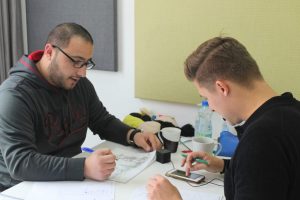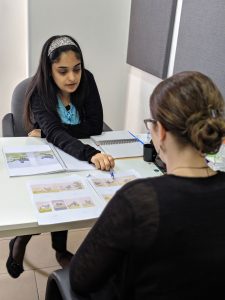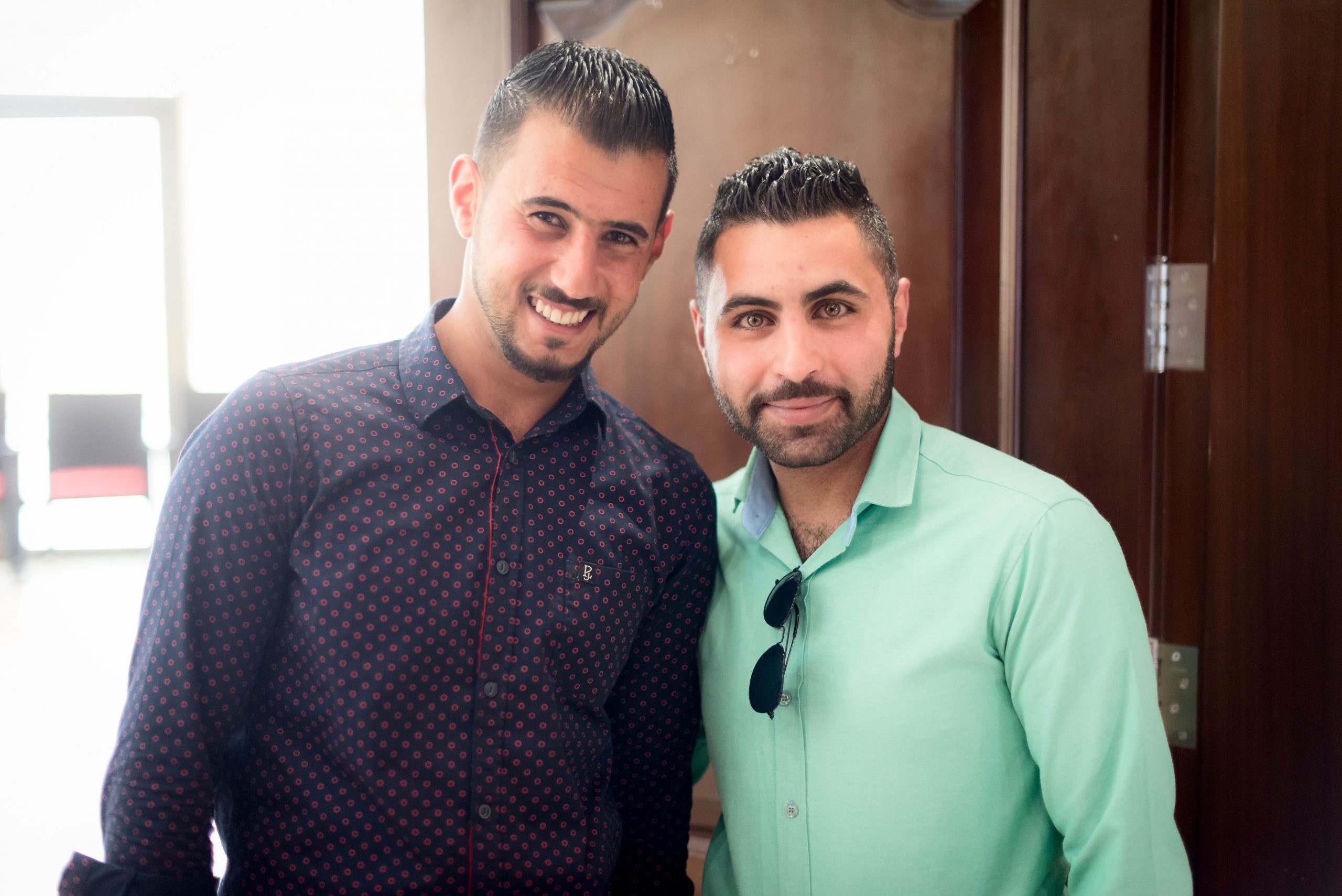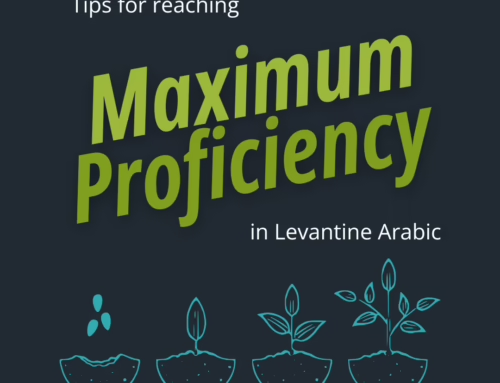Students who choose to learn Arabic – whether studying in their home country or in the Arab World – are faced with the challenge of diglossia; a linguistic situation where two different varieties of a language co-exist within a community. Usually, one of these varieties is considered prestigious (or in sociolinguistic terms, High) and the other considered “everyday” (or Low). In Arabic, the High variety is referred to as fusHa and the Low variety as ammiyah. The term fusHa includes both Modern Standard Arabic (MSA, the language of the media) and Classical Arabic (the language of the Qur’an). Ammiyah is referred to in English as Colloquial Arabic, dialects of Arabic, or simply “everyday spoken Arabic.”
The diglossic situation in the Arab World has proven to have complex implications for language learners.
Are both MSA and Colloquial Arabic necessary? If so, which should be learned first?

For students learning Arabic in their home country, options are limited. Most universities focus solely on teaching MSA, so learning Spoken Arabic outside of the Arab World often isn’t an option. But, what about those who are studying in the Arab World? The set of questions faced by learners in an immersion environment is different.
Linguists have debated whether varieties of Arabic constitute different languages or different “registers” on a continuum of formal to informal. Regardless, learning both MSA and Colloquial Arabic involves learning two sets of vocabulary, grammar patterns, syllable structures, and sociolinguistic rules. Mahmoud Al-Batal emphasizes that gaining proficiency in both varieties will require concerted effort in learning both varieties. (1)
If I study MSA, won’t I be able to live anywhere in the Arab World?
It’s not reasonable to think that intentional effort in learning one variety will lead to “picking up” of the other.
One reason students are motivated to study MSA rather than Spoken Arabic is because of the assumption that learning MSA will allow them to live anywhere in the world. And, while it’s the case that MSA is considered a “lingua franca” (common language between speakers of various language) in the Arab World, it’s also the High variety in terms of diglossia. It is a language of distance and formality, not of closeness and interaction. It’s true that when Arabic native speakers from different counties meet, they may use some MSA vocabulary. However, the grammar and sound system is based on their own dialect, rather than that of MSA.
Educated Arabs (who are fluent in Spoken Arabic) spend up to 12 years of school studying fusHa. Yet many say they don’t feel proficient in speaking or writing in formal Arabic. It seems a bit pretentious that non-Arab students of MSA – without a basis in Spoken Arabic – assume that within a year or two they will master the language. Karen Ryding, a curriculum author and Arabic scholar writes that “while the educational establishment has for decades enforced the concept of MSA first and foremost, this is completely the reverse of the native speaker’s experience with Arabic as a mother tongue” (3 p226).
If I focus my study on MSA, won’t I “pick up” the local dialect just by being immersed?
Many students who studied MSA in their home countries find that when they arrive in the Arab World, they can be understood. However, they have a very difficult time understanding the speech of those around them. Surprisingly, many dialects share more features (vocabulary, phonology, and grammar) with other dialects than they do with Classical Arabic (2). This points to the fact that the most helpful thing you can do to help understand multiple dialects is to learn one dialect really well.
Youssef Haddad discusses how learners who learn MSA first learn a phonology (sound patterns and syllable structures) that is not compatible with Spoken Arabic. Unlearning those patterns in order to speak a dialect naturally is very difficult. He says that a student who first studies MSA ends up with “a grammar that is, not only different from, but also more demanding than the grammar that the native speaker has” (4 p148).
If I focus on Colloquial Arabic, will I learn to read?

Not only does learning Colloquial Arabic make sense from a language acquisition perspective, but other researchers (5) have found that students who focus first on learning a variety of Spoken Arabic have increased motivation to continue learning long-term because of their ability to engage with the people around them. One of the most focused studies on this topic looked at learners who spent two years learning Arabic. One group of students studied Spoken Arabic for the first year and MSA for the second year, and the other group of students did the opposite. Qafisheh found that dropout rates were higher among those who first focused on MSA. While those who focused on MSA were initially better at reading and writing, the Spoken Arabic group quickly caught up and actually learned to read and write faster than the MSA group had. This is largely due to their broad vocabulary and focus on listening. The Colloquial Arabic group’s listening and speaking at the end of two years was also ahead of the MSA group.
Participate in Arabic Language and Arab Culture
Most Arabic learners who come to the Arab World have a desire to build relationships with Arabs. Without doubt, in any diglossic situation, strong relationships are built in the language spoken at home and in everyday life. MSA certainly plays a significant role in a literate and educated society. but learners will do themselves a favor if they focus their learning the way native speakers of Arabic do – first, learn to understand and speak. Then, as your vocabulary and understanding ability grows, and you develop relationships with Arabs, apply the literacy skills you have in your first language to learning to read and write. When it comes time to learning MSA, focus on learning the vocabulary (see Best Practices in Arabic Comprehension) and practice reading on your own. As you develop your literacy skills, keep yourself in close relationships with Arabs (in Arabic) to continue growing towards full participation in Arab life and culture.
References
- Al-Batal, M. (1992). Diglossia proficiency: The need for an alternative approach to teaching. In A. Rouchdy (Ed.), The Arabic language in America (pp. 284-304). Detroit, MI: Wayne State University Press.
- Trentman, E. (2011). L2 Arabic dialect comprehension: Empirical evidence for the transfer of familiar dialect knowledge to unfamiliar dialects. L2 Journal, 3(1).
- Ryding, K. C. (1995). Discourse competence in TAFL: Skill levels and choice of language variety in the Arabic classroom. In M. Al-Batal (Ed.), The teaching of Arabic as a foreign language: Issues and directions (pp. 223-231). Provo, Utah: American Association of Teachers of Arabic.
- Haddad, Y.A. (2006). Dialect and standard in second language phonology: The case of Arabic. SKY Journal of Linguistics, 19, 147–171.
- Al Zahrani, M.A. (2017). A Study on the Impact of Arabic Diglossia on L2 learners of Arabic: Examining Motivation and Perception (Master’s thesis). Retrieved from Arab World English Journal.
- Qafisheh, H.A. (1972). From Gulf Arabic into Modern Standard Arabic: A pilot study. Revised version of paper presented at the sixth annual ACTFL meeting, Atlanta, Georgia.





